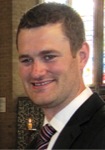San Francisco—He may be the god of love in Greek mythology, but when it comes to elective cesarean deliveries, EROS is all business.
Indeed, a British research group has found that its Enhanced Recovery in Obstetric Surgery (EROS) program significantly reduces length of stay in the hospital while keeping women satisfied with their care. The researchers stressed, however, that a multidisciplinary approach is critical to the success of EROS.
“A few of us got together and realized we’ve got the perfect obstetric population for enhanced recovery: They’re young, motivated to get home and have support once they leave the hospital,” said Daniel Abell, MBChB, consultant anesthetist at King’s College Hospital, in London. “So there didn’t seem to be any reason why we shouldn’t be doing this.”
Given that enhanced recovery programs have been successfully applied to many specialties throughout the world in recent years (see
Anesthesiology News, October 2013, page 1), Dr. Abell and his colleague, Saju Sharafudeen, MD, helped introduce the EROS program—a protocol-driven pathway—at King’s in June 2012. EROS aims to reduce length of stay by educating patients about their hospitalization, reducing starvation times for both solids and liquids, removing urinary catheters within six hours of anesthesia and promoting early mobilization.
What To Expect When You’re Expecting

Daniel Abell, MBChB
“One of the biggest issues we’ve faced has been managing expectation and disseminating information,” Dr. Abell told Anesthesiology News. “Because if they come in expecting to stay for four or five days, they’re going to stay for four or five days, no matter what you do.”
To help determine the efficacy of EROS, the researchers compared data collected before and after the initiation of the program. Collected data included patient demographics; details about the surgery and anesthesia; urinary catheter removal times; time to first mobilization after regional anesthesia; rates of readmission and recatheterization; and length of stay in the hospital.
As Dr. Abell reported at the 2013 annual meeting of the American Society of Anesthesiologists (abstract 2102), 60 women underwent elective cesarean deliveries at the institution; 45 of them were included in the EROS pathway (Table 1). When compared with 60 women who did not go through the enhanced recovery protocol, the women in the EROS group had significantly shorter lengths of stay and time to early mobilization (Table 2).
| Table 1. Patient Selection Criteria |
| Patient consent | Patient refusal |
| Uncomplicated elective cesarean delivery patients | High risk for perioperative obstetric complications |
| Minimal comorbidities | Unanticipated complications with surgery or anesthetic |
| Uncomplicated surgery and anesthetic | Unanticipated mother or baby outcomes |
| Supportive home and social circumstances | Diabetes or similar complex medical/psychosocial conditions |
| Agreement among midwife, surgeon and anesthetist that inclusion is appropriate | Lack of social support |
|
| Table 2. Women in EROS Program Enjoyed Better Outcomes |
Time to
mobilization | 22.01±6.12 h | 9.9±5.05 h
(<0.001) |
Time to
catheter removal | 21.95±5.84 h | 6.71±6.2 h
(<0.001) |
Time to first
spontaneous void | 25.38±5.5 h | 12.64±6.2 h
(<0.001) |
Hospital length
of stay | 3.3±2.94 d | 1.7±0.85 d
(<0.001) |
| EROS, Enhanced Recovery in Obstetric Surgery |
|
Although recatheterization rates were higher in the EROS group (13.3%) than in the non-EROS patients (0%), the seven-day readmission rate was lower (2.2% vs. 8.3%, respectively. All patients were followed up on days 1 and 7 postsurgery, and 90% said they “agreed” or “strongly agreed” that pain control was adequate to undertake routine tasks.
Nearly every woman (97.8%) who received EROS care said they would recommend the program to a friend and would undergo the same program for any future cesarean deliveries. The researchers said they received no reports of problems with mobilization, urination and visits to the patients’ general practitioners.
Much of the program’s success stems from education and a willingness to examine preexisting care patterns, Dr. Abell said. “Now our patients get an information booklet, a thorough preoperative briefing on their hospital stay and a phone call the day before their operation, all of which tell them about their stay and how they can get back to normal as quickly as possible.
“And now we’re really doing all the things that we should have been doing all along,” he added. “In the hospital setting, things often go on for years, and nobody actually looks at [them]. For example, we had a traditional policy where the urinary catheter didn’t come out until the morning after the C-section. The women would be sitting in their beds, completely fine, but they weren’t going to move because they still had the catheter in. So now we pay attention to the little things, and it’s made all the difference in the world.”
Scott Segal, MD, professor and chair of anesthesiology at Tufts University School of Medicine, in Boston, noted that these results might not have widespread applicability in the United States, where there are minimum lengths of stay for new mothers. “Since the [President Bill] Clinton administration, it’s been federal law that mothers cannot be required to be discharged earlier than two days after a normal vaginal delivery and four days after a cesarean delivery,” said Dr. Segal, who was not involved in the U.K. study.
“These investigators started at a baseline of 3.3 days [in the hospital]—already shorter than the U.S. standard—and reduced it to 1.7,” he continued. “It would be interesting to know if the women discharged earlier wanted to go or would have stayed longer if they had been given the opportunity. Nonetheless, the fact that they could show discharge readiness this early might reduce health system costs, but might also require incentives for women to accept early discharge, or change in federal law.”









